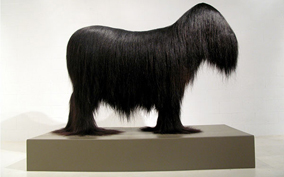Of Compost, Molecules and Insects, Art Is Born
- Submitted by: admin
- Paint and Sculpture
- United States
- 05 / 04 / 2010

The word organic means different things to different people. To the gardener it means compost heaps. To the chemist it means carbon compounds.
To the artist Fabian Peña, it means American cockroaches, those chunky nocturnal charmers often seen skittering around drainpipes or on the street. “I have collected cockroaches from many different places,” Mr. Peña said.
“From Cuba, Mexico, Miami, Houston, everywhere I travel.”
ORGANIC The artist Levi van Veluw uses his flesh as soil, adding moss and leaves.
He kills the cockroaches with a spray, pops them into a jar, takes them back to his studio in Florida, and then puts their parts to work in his art. He glues their legs together into long, lacy cylinders that look like giant larval casings. He arranges their wings into medically precise images of a human skull, foot bones and hand bones, all scaled to his own head and appendages.
Mr. Peña likes the medium of cockroach aesthetically, the way he can use the different tones in the wings as his palette to convey light and shadow. He likes it metaphorically, how we are disgusted by something with which we have so much in common — the same taste in foods, the same easy adaptability to every possible niche. “Cockroaches are a witness to our daily lives,”
Mr. Peña said. He also likes his medium pragmatically. “It’s a material that I can easily find,” he said, “and it’s cheaper than buying paint.”
Mr. Peña is among the growing ranks of artists who have gone natural, who are scavenging the world’s vivarium and rummaging through the life sciences in search of materials, ideas, cosmic verities, tragicomic homilies, personal agency, a personal
agent, a way to stand out in the crowd.
Laura Splan, a Brooklyn-based artist and certified phlebotomist, decorates wallpaper with her own blood. On first seeing the wallpaper, viewers have “a pleasant visual engagement” with it, Ms. Splan said. But after learning of the main ingredient from an accompanying card, she said, a “more complicated” reaction unfolds, a blend of ick and fascination, rearing back and coming closer, and mutterings of “I sure hope she doesn’t have any blood-borne diseases.” With similar transfiguring glee, Levi van Veluw of the Netherlands treats the flesh of his face and torso as topsoil, slathering on layers of moss, grasses, leaves and florets until he looks like a kind of Julius Caesar Chia Pet.
Many examples of mulchy, redolent, unmistakably organic art are on display in a new exhibit called “Dead or Alive,” at the Museum of Arts and Design in New York.
The museum recently hosted a round-table luncheon in which scientists and artists
addressed the hardy evergreen issue of how much the arts and sciences had in common and where they differed.
The basic conclusion: both enterprises are important, difficult, creative, driven by insatiable curiosity and a desire to solve problems, but artists are allowed to make stuff up and scientists really shouldn’t. Whatever the symposial chin rubbings, some practitioners of the new crossover art have serious scientific credentials and are not afraid to use them.
Source: www.nytimes.com
Comments